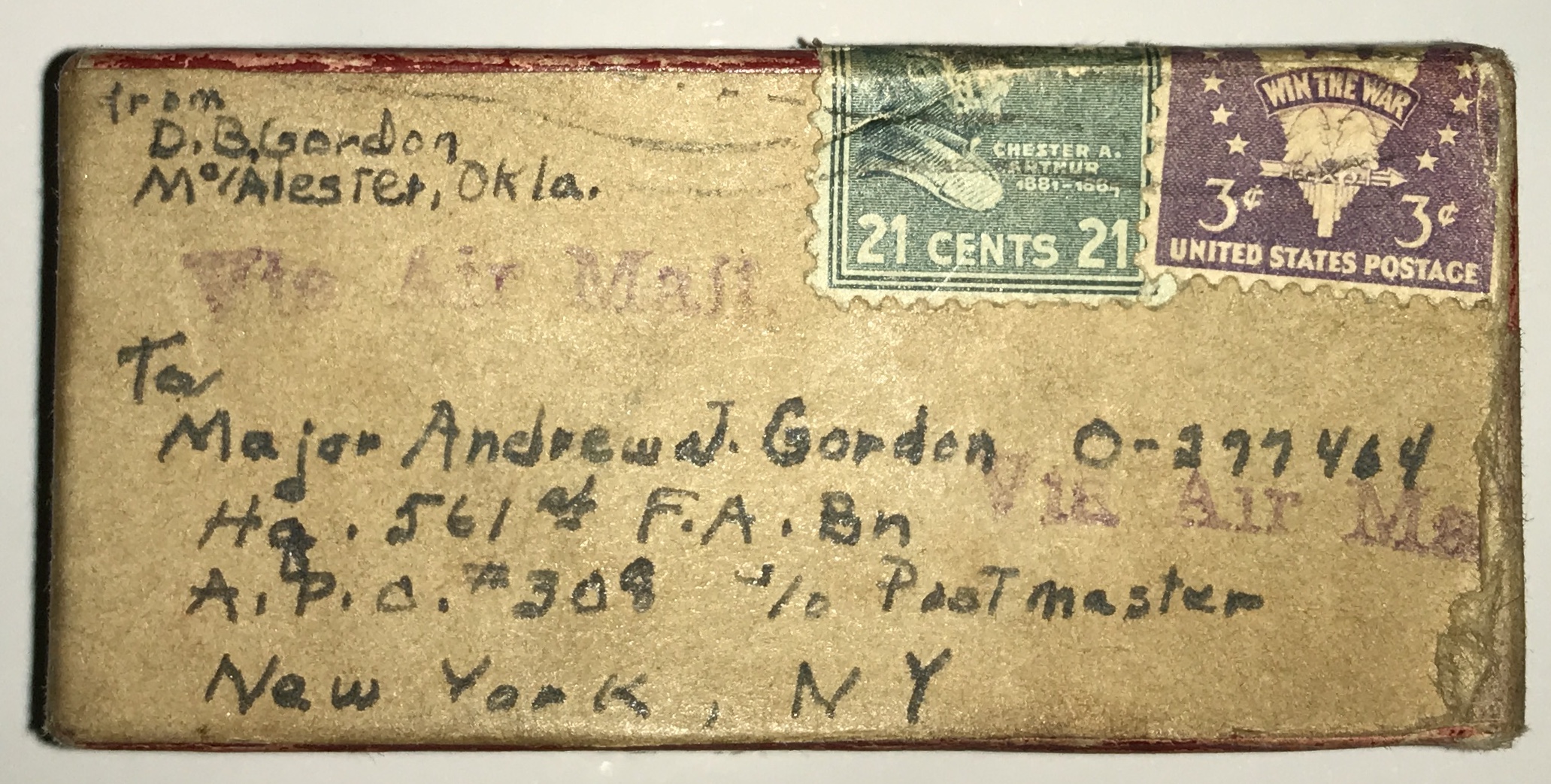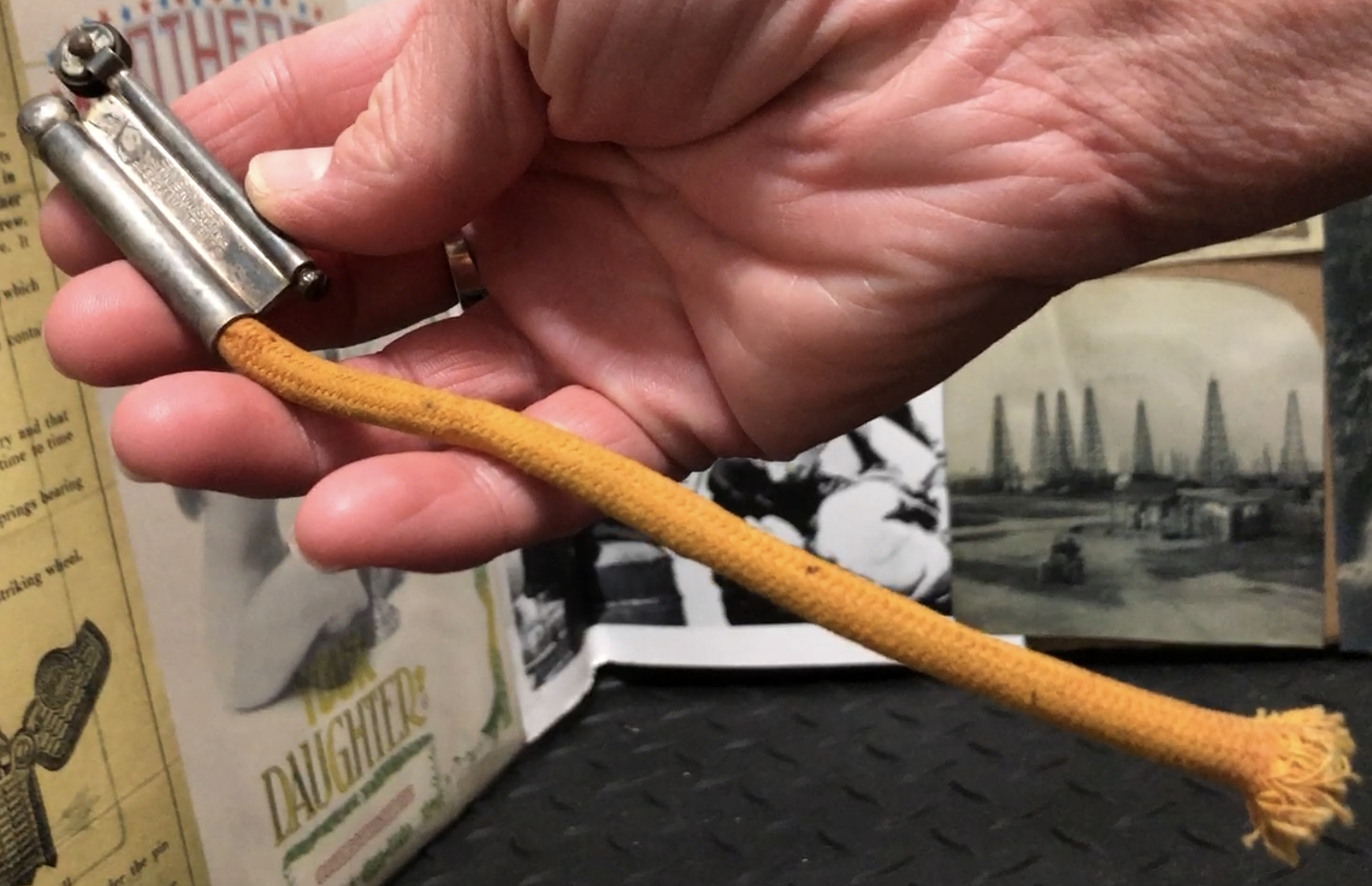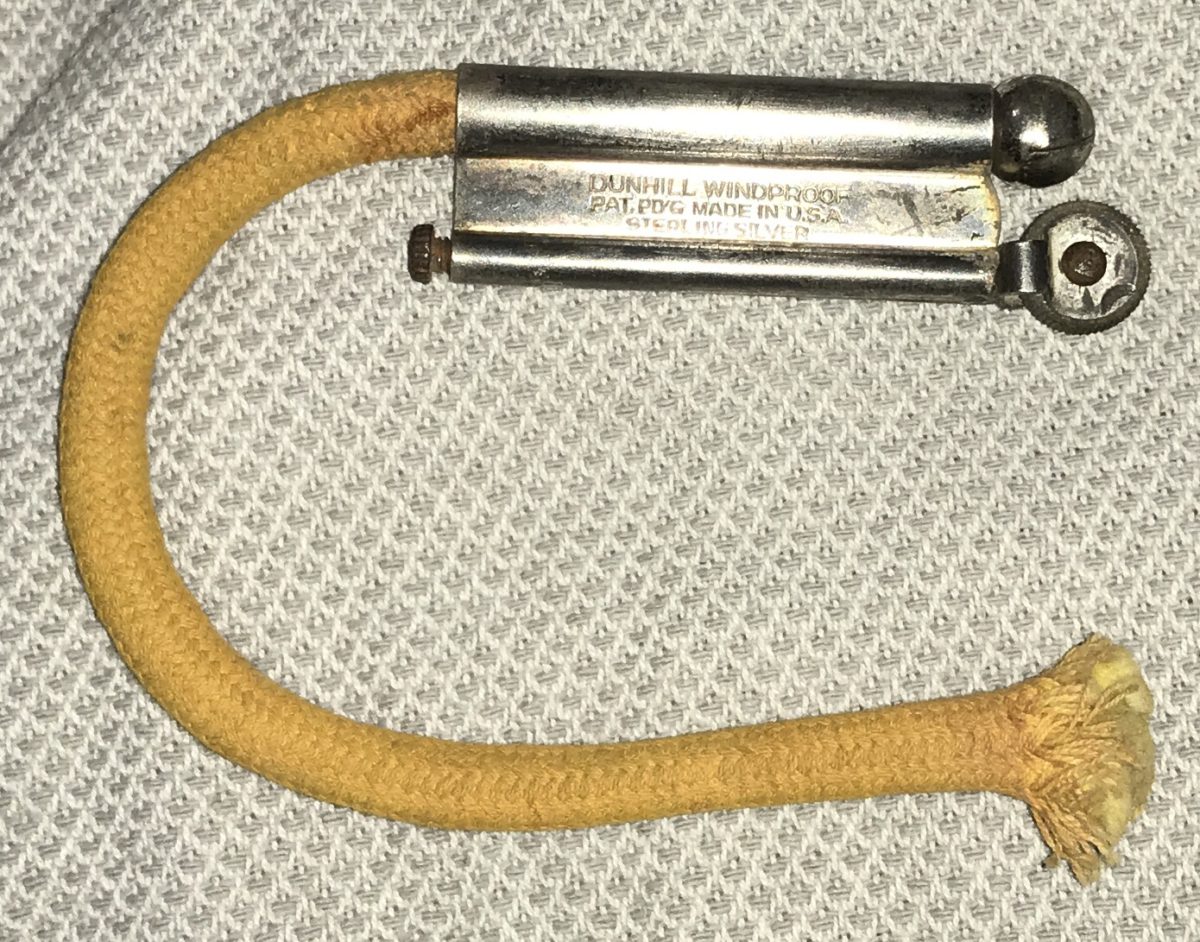This vintage trench lighter will combust your joint without you ever having to worry about the fuel evaporating into oblivion.
A Lighter That Never Needs More Fuel
At first glance, the Dunhill Windproof Lighter may look familiar in that it has similar or even identical features to other trench or petrol lighters of its day, while at the same time having one very obvious difference, that long-ass orange rope sticking out the bottom.
It’s funny because until I laid hands on one of my own and began to research this particular Dunhill lighter and its function, I always assumed that long orange rope was at least damp with petrol fluid. I know that petrol isn’t particularly volatile but that long rope dangling down beneath where the sparks come out certainly looked dangerous to me.
That is not the case. It is apparently impregnated with a chemical that aids in the embers’ catching but the rope never proceeds to flame. So, the fuel source is different but it is still pretty cool to pull this lighter out of the box after so long and it fire up without the need to refuel. Can you imagine if a Zippo retained its fuel like that?
A Glimpse Into Olden Times
The lighter was found in what appears to be its original Dunhill London USA box that has been partially covered over with brown paper and labeled and stamped for mailing. The 21 cent Chester Arthur stamp was first issued in 1938 but the 3 cent Win The War stamp was first issued in 1942 which means this would have been mailed in or after 1942.
The box contained the original instruction paperwork, the lighter with fusee installed and an extra fusee(or rope, I’m not sure if these words are exactly interchangeable.) I wish I could peel that brown paper off and salvage the finish of the original box but there’s no way to remove it without causing further damage to the box. The black bottom and red top box pattern match those of the period to which the mailing label lends provenance.
The return address was pretty basic considering this was well before the development of the zip code system, consisting only of a name in McAlester, Oklahoma. The destination address, while it says New York, was actually to a major at an APO(army post office) overseas military base address. My guess would be the lighter was mailed to the major who used it in service and I certainly hope he returned home with his lighter(I did a Google search and could find no mention of this major. Any light that a reader could shed on the subject would be much appreciated, just leave your comments at the bottom of the page.)
The condition of the box is not great, so I don’t believe it will make much difference in the value of this lighter but the stamps and addresses providing background to the Dunhill Windproof Lighter’s place in history is pretty cool and provides evidence of its authenticity.
How Does It Work?
Have you ever started a fire? I’m not talking about an accident where you threw a cigarette butt out the window and caught half the county on fire or that you are able to turn on a stove, furnace or any other device designed to produce flame. Rather, a circumstance you found yourself in where for warmth or cooking or whatever, a fire was necessary and you were able to produce one with your bare hands and raw materials without “cheating” and using a lighter or pouring gasoline on the campfire, say.
If you have started a fire from scratch, then you’ll understand what to do in order to make the Dunhill Windproof Lighter function properly. Lighting this lighter is the same basic function as lighting kindling and fanning the embers to start a campfire but I don’t think that rope will produce a flame no matter how hard you stoke it.
That being the case, I still find the “windproof” moniker interesting as the wind will actually aid this lighter’s function by stoking the embers for the smoker who could then just inhale and light his smoke.
To Flame Or Not To Flame
A short list of bullet points both for the pro and the con to provide context to the Dunhill Windproof Lighter’s versatility or lack there of.
Pros:
- Never worry about your fuel evaporating away ever again
- Wind is an aid, not a deterrent
- No fuel to leak and burn your skin
- The flameless design is less evident than an open flame, hence the nickname: “foxhole lighter” as it was less likely to give away your position
- Be unique! None of your friends are using a sterling silver 1940s era Dunhill Windproof fusee trench lighter to light their cigarettes
Cons:
- Can be cumbersome on a still, windless day to blow to stoke the ember of the rope while at the same time inhaling to light your cigarette
- The nature of the flameless design will make it impossible to use the Dunhill Windproof Lighter to light some pipes(the angles of some pipes require a flame to reach down into them.)
- Not the most stylish lighter around, has a pretty utilitarian look about it
What Are You Waiting For? Get On Board!
We are always looking for lighters to repair and to tell stories about. If you have a vintage petrol lighter in need of repair, leave a comment at the bottom of the page or send an email. Most petrol lighter repairs are minor and very simple. In many cases, I can instruct you how to make the necessary repairs yourself. I have repaired many vintage petrol lighters for customers who mailed them to me and I am usually able to provide this service at no cost, with the customer only paying to mail their lighter to me and I pick up the postage going back to them. These arrangements are made on an individual basis and you only need to ask to take advantage.
You can join our email list to the right on any page at DependableFlame.com.
Like us on Pinterest, Twitter and Facebook.
Please subscribe to the DependableFlame YouTube channel. We are committed to video documentation of every vintage cigarette lighter that we put back into service.
Please leave any questions or comments you may have about medical marijuana, vintage cigarette lighters or selling on Ebay.

Dear Sir-I received a very clean Occupied Japan camera lighter off of EBay and it’s had a very weak spark from the get go, resulting in sporadic lighting:( Very little use and the flint that was in there was relatively new and had the correct wear pattern on it. Replacing the flint and filling up the lighter has had no effect on it lighting more continuously. Am wondering if I should remove the sparking wheel and wire brush it. FWIW, I perform mnt. for a living and have an original IMCO USA trench lighter (which came with a seized flint NIB). Appreciate any troubleshooting tips. This is an automatic lighter, similar to the Thorens lighters, where the pivoting lighter cap provides the motive action for the flint wheel. The wick appears to be original and I am wondering if it needs a better one. Appreciate any feedback-John in Texas
Hello, John and thanks for the question. I haven’t had any of those MIOJ Semi-Automatic mechanisms apart just yet so I can’t say with any certainty what’s causing your problem but you hit on some issues that can not hurt your cause to attend to and definitely could be the cause and help pinpoint how to get your lighter functioning more reliably.
A soft wire brush to the file wheel could clear it of old debris that is inhibiting a solid spark.
There are many times where an old wick may appear okay but it’s actually contaminated with something that prevents proper ignition of the flame.
And you are correct about the motion, momentum of the lid is paramount to achieving the force necessary. They have never seemed all that well made to me, so I’m not sure how much fine tuning can be done. If you’ll send pictures, I’ll see if I can find a similar lighter to do a video on.✌️
I own a couple of vintage items with US military service numbers on them, and have been trying to find out more about their owners … so I had a go with your Major Gordon. Unfortunately he wasn’t in the database I tried (though it’s incomplete).
https://aad.archives.gov/aad/fielded-search.jsp?dt=893&tf=F&cat=WR26&bc=,sl
We already know from the package addressed to him that he was a commissioned officer, as the “O” (that’s a capital O not a zero) in front of his service number indicates. Most of the information in this article is about people who weren’t commissioned officers, but still pretty interesting.
https://www.amyjohnsoncrow.com/how-to-decode-a-wwii-army-serial-number/
I’ll keep looking, but good ol’ Wikipedia provides this tidbit in the meantime. That 6-digit service number suggests that the Major joined the officer corps sometime between 1935 (when the Army boosted the number of digits in officer service numbers to 6 digits) and 1942 (when they were increased again to 7 digits).
The service number in the “O-xxxxxx” format may also be consistent with him joining the military pre-1942, since Wikipedia claimed that had been phased out by then. I’m assuming that he might have told his friends/family the old way.
https://en.wikipedia.org/wiki/Service_number_%28United_States_Army%29#World_War_II
Interesting puzzle! And thank you for sharing the Dunhill instructions. Some of my friends are in a military re-enactment group, and they hadn’t heard of rope lighters before … I found a (non-silver) example they could examine, and sent them the link to your article so they could look at the official Dunhill instruction sheet.
Thank you Lisa. I appreciate all the information. I think a lot about collectors and people who like to use old lighters to light up but I had never considered military reenactments, though I have sold a few lighters to prop houses and set departments for TV shows. I’ve fallen down a rabbit hole from time to time looking for info but dating and getting info from that service number sounds very confusing. I also appreciate you pointing folks toward my site, I’m working very hard to make it and the YouTube channel as helpful as possible.✌️
The unit is the 561st Field Artillery Battalion. As a Major, Andrew J. Gordon was likely the Battallion Executive Officer (BN XO) or the second in charge after the Battalion Commander. The u it was at Normandy and the Ardennes (Battle of the Bulge). There’s a memorial to the unit at Fort Sill, Oklahoma. You can contact the historian there who may be able to help you get more information about Major Andrew J. Gordon.
Thank you for all of the info Bill!✌️
Fort Sill me.orial for the 561st Field Artillery Batallion.
https://www.legion.org/memorials/241335/561st-field-artillery-battalion
Fort Sill Army Field Artillery Museum. You should contact them.
https://sill-www.army.mil/famuseum/
Do you need flints for the Fox hole lighters with the orange fuse ..I have a sterling silver in perfect condition in original box? If you do where can you get them (flints)?
Yes, you will need flint for the fusee lighter. Zippo or Ronson flints that you can buy from Amazon will work just fine. There are links here to purchase them from Amazon, where I earn a commission.✌️
Dear Sir
I obtained a used Dunhill Windproof lighter.
It is missing the ball and rope.
Can I buy the rope somewhere?
Also I believe the ball’s function is to properly extinguish the ember after use, and imagine that its genuine replacement is hard to find if not impossible. Any suggestions for an alternative would be appreciated.
Thank you.
Ken
Hey Ken, I appreciate the question and thank you for stopping by. I wrote an article a couple weeks ago about this exact situation you find yourself in and offer some tips on where you might be able to find the parts that you need to make your lighter whole again. The ball is on a hook and is there to block the end of the tube and thereby extinguish the ember on the rope. The most likely place to find what you need are old lighter listings on Ebay. It’s searching for a needle in a haystack but that’s your best bet.